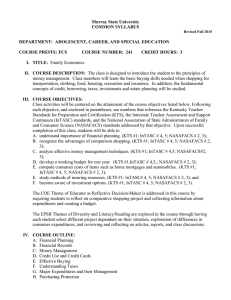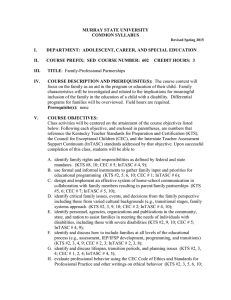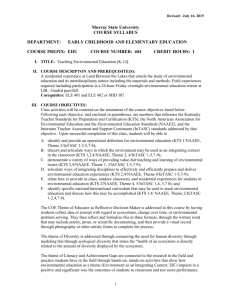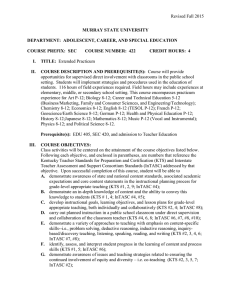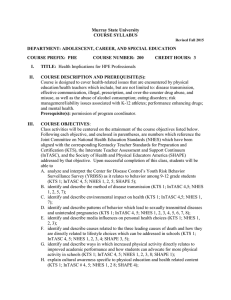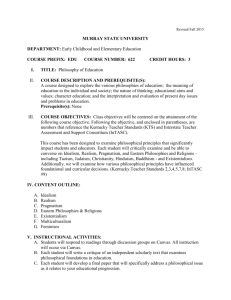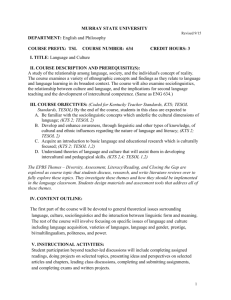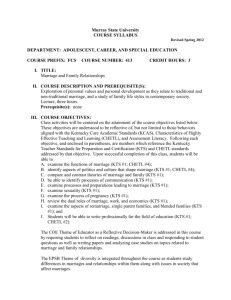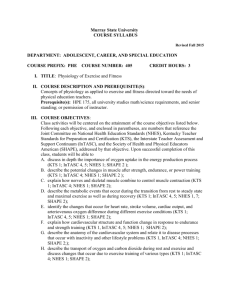Murray State University
advertisement
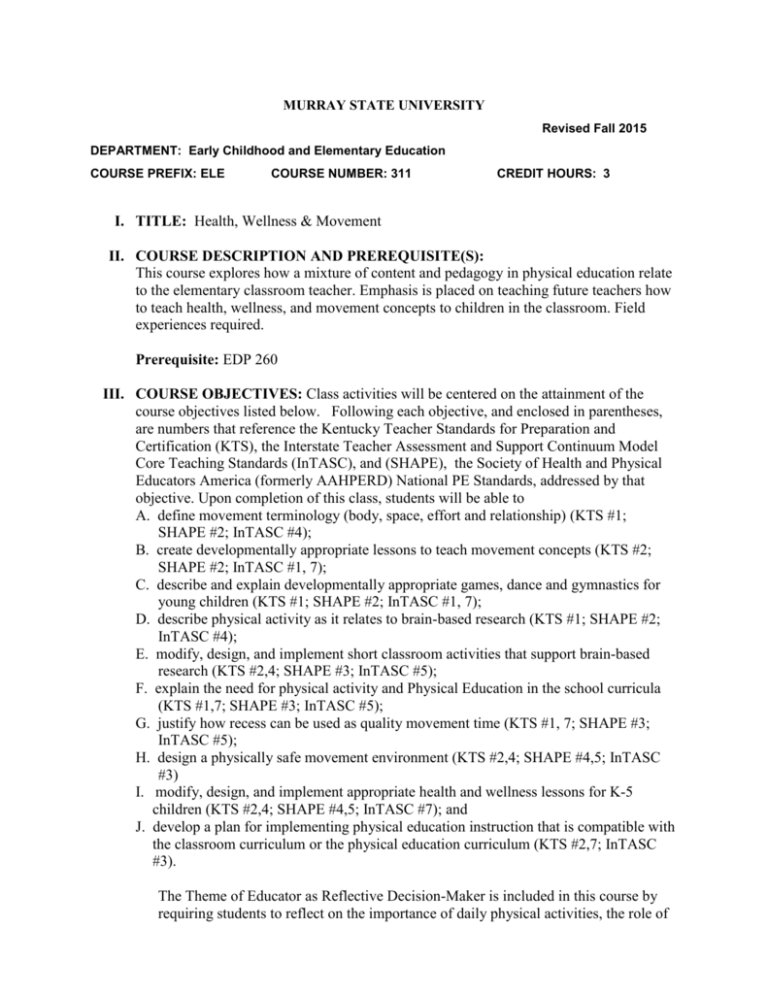
MURRAY STATE UNIVERSITY Revised Fall 2015 DEPARTMENT: Early Childhood and Elementary Education COURSE PREFIX: ELE COURSE NUMBER: 311 CREDIT HOURS: 3 I. TITLE: Health, Wellness & Movement II. COURSE DESCRIPTION AND PREREQUISITE(S): This course explores how a mixture of content and pedagogy in physical education relate to the elementary classroom teacher. Emphasis is placed on teaching future teachers how to teach health, wellness, and movement concepts to children in the classroom. Field experiences required. Prerequisite: EDP 260 III. COURSE OBJECTIVES: Class activities will be centered on the attainment of the course objectives listed below. Following each objective, and enclosed in parentheses, are numbers that reference the Kentucky Teacher Standards for Preparation and Certification (KTS), the Interstate Teacher Assessment and Support Continuum Model Core Teaching Standards (InTASC), and (SHAPE), the Society of Health and Physical Educators America (formerly AAHPERD) National PE Standards, addressed by that objective. Upon completion of this class, students will be able to A. define movement terminology (body, space, effort and relationship) (KTS #1; SHAPE #2; InTASC #4); B. create developmentally appropriate lessons to teach movement concepts (KTS #2; SHAPE #2; InTASC #1, 7); C. describe and explain developmentally appropriate games, dance and gymnastics for young children (KTS #1; SHAPE #2; InTASC #1, 7); D. describe physical activity as it relates to brain-based research (KTS #1; SHAPE #2; InTASC #4); E. modify, design, and implement short classroom activities that support brain-based research (KTS #2,4; SHAPE #3; InTASC #5); F. explain the need for physical activity and Physical Education in the school curricula (KTS #1,7; SHAPE #3; InTASC #5); G. justify how recess can be used as quality movement time (KTS #1, 7; SHAPE #3; InTASC #5); H. design a physically safe movement environment (KTS #2,4; SHAPE #4,5; InTASC #3) I. modify, design, and implement appropriate health and wellness lessons for K-5 children (KTS #2,4; SHAPE #4,5; InTASC #7); and J. develop a plan for implementing physical education instruction that is compatible with the classroom curriculum or the physical education curriculum (KTS #2,7; InTASC #3). The Theme of Educator as Reflective Decision-Maker is included in this course by requiring students to reflect on the importance of daily physical activities, the role of fitness testing, and the integration of developmentally appropriate health, wellness, and movement activities throughout the regular elementary curriculum. IV. CONTENT OUTLINE: A. Movement Concepts – body, space, effort and relationships B. Motor Skills – throwing, catching, kicking, punting, dribbling, volleying, striking with paddles and rackets, striking with long-handled implements, travelling, chasing, fleeing, dodging, balancing, jumping and landing, transferring weight, and rolling C. Movement in Dance: Elements of dance – time, force, flow; History and Culture of Dance, Purposes of dance: ceremonial, artistic, recreational D. Games Education - Children creating games (purpose of, history of, format or types) E. Brain-Based Research and Activities (brain and oxygen circulation, neurons, energizers, etc.) F. Physical Activity guidelines and principles G. Position statement of Recess – SHAPE (formerly AAHPERD) H. Health related fitness components – definitions, how to, FITT principle, etc. I. Wellness & Health – blood-born pathogens, hygiene, rudimentary first aid, addressing children’s special physical needs J. Interdisciplinary instruction and thematic units across the curriculum V. INSTRUCTIONAL ACTIVITIES: Lecture/discussion, assignments, projects, small group activities, lab experiences in the gymnasium, peer teaching, technology (computers, pedometers, PECentral.org) FIELD, CLINICAL, AND/OR LABORATORY EXPERIENCE: Students will observe and facilitate health, wellness, and movement activities with elementary students for five clock hours. To earn a grade in this course, students must successfully complete the required field experiences and record the hours and related components on the LiveText FEM site. Students are also expected to record field experiences in KFETS. VI. TEXT(S) AND REFERENCES: Kovar, S., Combs, C., Campbell, K., Napper-Owen, G., & Worrell, V. (2012) Elementary classroom teachers as movement educators, 4th ed. New York: McGraw Hill. PECentral.org, Journal articles, Videotaped lessons, Computer labs, Media and resource centers, Library, and additional educational websites as needed. VII. EVALUATION AND GRADING PROCEDURES: Grades will be awarded based upon this scale: A: 90%-100% B: 80%-89% C: 70%-79% D: 60%-69% E: 0%-59% Test #1 Test #2 Midterm Test #3 Test # 4 (Chapters 1-3) (Chapters 4-6) (Chapters 1-6) (Chapters 7-9) (Chapters 10-12) 5% 5% 40% 5% 5% Final Exam (Chapters 7-12) 40% 100% VIII. ATTENDANCE POLICY: Students are expected to adhere to the MSU Attendance Policy outlined in the current MSU Bulletin. X. ACADEMIC HONESTY POLICY: Murray State University takes seriously its moral and educational obligation to maintain high standards of academic honesty and ethical behavior. Instructors are expected to evaluate students’ academic achievements accurately, as well as ascertain that work submitted by students is authentic and the result of their own efforts, and consistent with established academic standards. Students are obligated to respect and abide by the basic standards of personal and professional integrity. Violations of Academic Honesty include: Cheating - Intentionally using or attempting to use unauthorized information such as books, notes, study aids, or other electronic, online, or digital devices in any academic exercise; as well as unauthorized communication of information by any means to or from others during any academic exercise. Fabrication and Falsification - Intentional alteration or invention of any information or citation in an academic exercise. Falsification involves changing information whereas fabrication involves inventing or counterfeiting information. Multiple Submission - The submission of substantial portions of the same academic work, including oral reports, for credit more than once without authorization from the instructor. Plagiarism - Intentionally or knowingly representing the words, ideas, creative work, or data of someone else as one’s own in any academic exercise, without due and proper acknowledgement. Instructors should outline their expectations that may go beyond the scope of this policy at the beginning of each course and identify such expectations and restrictions in the course syllabus. When an instructor receives evidence, either directly or indirectly, of academic dishonesty, he or she should investigate the instance. The faculty member should then take appropriate disciplinary action. Disciplinary action may include, but is not limited to the following: 1) Requiring the student(s) to repeat the exercise or do additional related exercise(s). 2) Lowering the grade or failing the student(s) on the particular exercise(s) involved. 3) Lowering the grade or failing the student(s) in the course. If the disciplinary action results in the awarding of a grade of E in the course, the student(s) may not drop the course. Faculty reserve the right to invalidate any exercise or other evaluative measures if substantial evidence exists that the integrity of the exercise has been compromised. Faculty also reserve the right to document in the course syllabi further academic honesty policy elements related to the individual disciplines. A student may appeal the decision of the faculty member with the department chair in writing within five working days. Note: If, at any point in this process, the student alleges that actions have taken place that may be in violation of the Murray State University NonDiscrimination Statement, this process must be suspended and the matter be directed to the Office of Institutional Diversity, Equity and Access. Any appeal will be forwarded to the appropriate university committee as determined by the Provost. XI. NON-DISCRIMINATION POLICY AND STUDENTS WITH DISABILITIES: Policy Statement Murray State University endorses the intent of all federal and state laws created to prohibit discrimination. Murray State University does not discriminate on the basis of race, color, national origin, gender, sexual orientation, religion, age, veteran status, or disability in employment, admissions, or other provision of services and provides, upon request, reasonable accommodation including auxiliary aids and services necessary to afford individuals with disabilities equal access to participate in all programs and activities. For more information, contact the Executive Director of Institutional Diversity, Equity and Access, 103 Wells Hall, (270) 809-3155 (voice), (270) 809-3361 (TDD). Students with Disabilities Students requiring special assistance due to a disability should visit the Office of Student Disability Services immediately for assistance with accommodations. For more information, students should contact the Office of Student Disability Services, 423 Wells Hall, Murray, KY 42071. 270-809-2018 (voice) 270-809-5889 (TDD) XII. FLAG SYSTEM/CONTINUOUS ASSESSMENT: Student progress is continuously assessed throughout the teacher preparation program. Appropriate professional characteristics and dispositions, in addition to academic achievement, are assessed. Positive and negative flags are submitted by faculty to Teacher Education Services and then presented to admissions committee. Negative flags are carefully reviewed to make a determination as to whether a student should be denied admission OR if a professional development plan will be designed for the student’s progress towards program completion. NEGATIVE FLAGS MAY BE GROUNDS FOR DENIAL OF ADMISSION TO TEACHER EDUCATION AND/OR STUDENT TEACHING. Note: Instructor of ELE 311 reserves the right to make changes in the course activities and assignments as deemed necessary during the semester.
